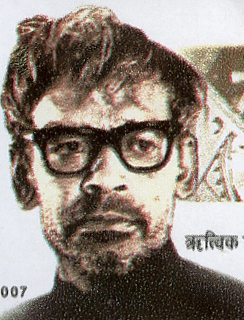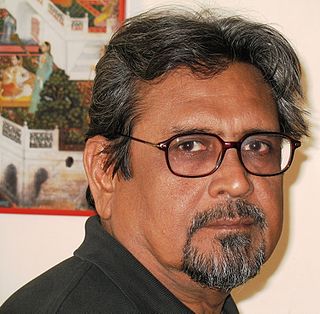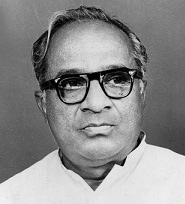
Ritwik Kumar Ghatak was a noted Indian film director, screenwriter, actor and playwright. Along with prominent contemporary Bengali filmmakers like Satyajit Ray, Tapan Sinha and Mrinal Sen, his cinema is primarily remembered for its meticulous depiction of social reality, partition and feminism. He won the National Film Award's Rajat Kamal Award for Best Story in 1974 for his Jukti Takko Aar Gappo and Best Director's Award from Bangladesh Cine Journalist's Association for Titash Ekti Nadir Naam. The Government of India honoured him with the Padma Shri for Arts in 1970.

Meghe Dhaka Tara is a 1960 film written and directed by Ritwik Ghatak, based on a social novel by Shaktipada Rajguru with the same title. It stars Supriya Choudhury, Anil Chatterjee, Gita Dey, Bijon Bhattacharya, Niranjan Roy, and Gyanesh Mukherjee. It was part of a trilogy consisting of Meghe Dhaka Tara (1960), Komal Gandhar (1961), and Subarnarekha (1962), all dealing with the aftermath of the Partition of Bengal during the Partition of India in 1947 and the refugees coping with it.

Allauddin Khan, also known as Baba Allauddin Khan was an Indian sarod player and multi-instrumentalist, composer and one of the most notable music teachers of the 20th century in Indian classical music. For a generation many of his students, across different instruments like sitar and violin, dominated Hindustani classical and became one of the most famous exponents of the form ever, including Ravi Shankar and Ali Akbar Khan.

Alam Ara is a 1931 Indian Hindustani-language historical fantasy film directed and produced by Ardeshir Irani. It revolves around a king and his two wives, Navbahaar and Dilbahaar, who are childless; soon, a fakir tells the king that the former wife will give birth to a boy, later named Qamar, but the child will die following his 18th birthday if Navbahaar cannot find the necklace he asks for. Meanwhile, the king finds out that Dilbahaar falls for the senapati Adil, leading the king to arrest him and evicts his pregnant wife, who later gives birth to Alam Ara (Zubeida).

Singanalluru Puttaswamaiah Muthuraj, better known by his stage name Dr. Rajkumar, was an Indian actor, singer and producer who worked in Kannada cinema. Through his over five-decade long career of over 200 films, he was regarded one of the most pivotal and influential figures of the Kannada film industry. His films were praised for acting as a bridge between the popular and art films because of the theme of the story and their treatment. He debuted as a child actor in the 1942 Kannada film Bhakta Prahlada. His first role as an adult came in Sri Srinivasa Kalyana (1952) and as a lead, two years later, in Bedara Kannappa, which gave him stardom. He debuted as a singer with the track Om Namaha Shivaya from the 1956 film Ohileshwara. In 1960, he made his debut as a producer by producing Ranadheera Kanteerava. According to Ashish Rajadhyaksha and Paul Willemen in the book Encyclopedia of Indian Cinema, Ranadheera Kanteerava was the first "big hit" in Kannada cinema. In a film career spanning fifty years, Rajkumar received eleven Karnataka State Film Awards, including nine Best Actor and two Best Singer awards, eight Filmfare Awards South, and one National Film Award. Along with Vishnuvardhan and Ambareesh, he is counted in Kannada cinema's "triumvirate" as its most celebrated actor.
Dev Anand, was an Indian actor, writer, director and producer known for his work in Hindi cinema. Anand is considered one of the greatest and most successful actors in the history of Indian cinema. Through a career that spanned over six decades, he worked in more than 100 films. Anand is a recipient of four Filmfare Awards, including two for Best Actor. The Government of India honored him with Padma Bhushan, Indian third highest civilian honour in 2001 and with Dadasaheb Phalke Award in 2002.

Kamal Haasan is an Indian actor, screenwriter, film director, film producer, and dance choreographer who works primarily in Tamil cinema. At the age of 5, he debuted as a child actor in the 1960 Tamil film Kalathur Kannamma, directed by A. Bhimsingh, which won him the President's Gold Medal. Since then, he has acted in over 230 films in Tamil and other languages including Malayalam, Hindi, Telugu, Kannada, and Bengali. After a few projects as a child artist, he took a break to continue his education. He later concentrated on dance choreography and worked as an assistant choreographer. During this time, he made uncredited appearances in a few films which he worked on.
Kumar Shahani was an Indian film director and screenwriter, best known for his parallel cinema films Maya Darpan (1972), Tarang (1984), Khayal Gatha (1989) and Kasba (1990). His films won the Filmfare Critics Award for Best Film in 1972, 1990 and 1991. Due to his dedication to formalism, and with the reputation of his first feature—Maya Darpan being considered among Indian cinema's first formalist films—critics and film enthusiasts often associated him with filmmakers such as Pier Paolo Pasolini, Andrei Tarkovsky and Jacques Rivette. He was also known as a teacher at his alma mater, the Film and Television Institute of India, and as a theorist of cinema. His book of 51 essays Kumar Shahani: The Shock of Desire and Other Essays, was edited by Ashish Rajadhyaksha and published by Tulika Books in 2015.

Kalidas is a 1931 Indian biographical film directed by H. M. Reddy and produced by Ardeshir Irani. It is notable for being the first sound film in the Tamil and Telugu languages, and the first sound film to be made in a language from South India. It was based on the life of the Sanskrit poet Kalidasa; it featured P. G. Venkatesan in the title role and T. P. Rajalakshmi as the female lead, with L. V. Prasad, Thevaram Rajambal, T. Susheela Devi, J. Sushila, and M. S. Santhanalakshmi in supporting roles.
Shivaji, was the founder of the Maratha Empire in India. He is considered a prominent historical figure in India. A number of films, books, plays and television serials have been produced about his life and about figures associated with him.

Amrit Gangar is an Indian film scholar, historian, critic, curator and writer from Mumbai, Maharashtra, India.

Singanallur Venkataramana Iyer Sahasranamam, also known as S. V. S., was an Indian actor and director. Primarily a theatre actor, he also worked in over 200 films, mainly in Tamil cinema.

Hunsur Krishnamurthy was an Indian playwright, film director, producer, actor, screenwriter and lyricist in Kannada cinema.

Balidan, also called Sacrifice, is a 1927 Indian silent film directed by Naval Gandhi and based on a play by Rabindranath Tagore. It was produced by Orient Pictures Corporation. Balidan is cited as one of the top ten lost films of Indian Cinema by P. K. Nair. Hailed as "an excellent and truly Indian film" by The Indian Cinematograph Committee, 1927–28, Balidan was used by them as one of the films to "show how 'serious' Indian cinema could match Western standards".
Major Chandrakanth is a Tamil-language play written by K. Balachander and staged in the 1960s. It was adapted into a Hindi film titled Oonche Log in 1965, a Tamil namesake film in 1966, a Telugu film titled Sukha Dukhalu in 1968, a Malayalam film titled Karthavyam in 1982, and a Kannada film titled Karune Illada Kanoonu in 1983.

Dimple Kapadia is an Indian actress who predominantly appears in Hindi films. She was discovered by Raj Kapoor at age 14, who gave her the title role in his teen romance Bobby (1973), opposite his son Rishi Kapoor. The film became a massive commercial success and made her an overnight star. Her role as a Christian teenager from Goa established her as a youth fashion icon and won her the Filmfare Award for Best Actress. Kapadia retired from acting following her marriage to Indian actor Rajesh Khanna earlier in 1973, and returned to the film industry in 1984, after her separation from Khanna. The release of her comeback film, Saagar, was delayed, with Zakhmi Sher becoming the second film of her career. Released in 1985, Saagar earned her a second Best Actress award at Filmfare, and she went on to establish herself as one of the leading actresses of Hindi cinema in the 1980s and early 1990s. The early roles she played following her return included the Hitchcockian thriller Aitbaar (1985), for which she received positive reviews, and the commercially successful action films Arjun (1985) and Janbaaz (1986). During this period, she acted in several films in South India, which she admitted to having made for financial gain and dismissed their quality.











